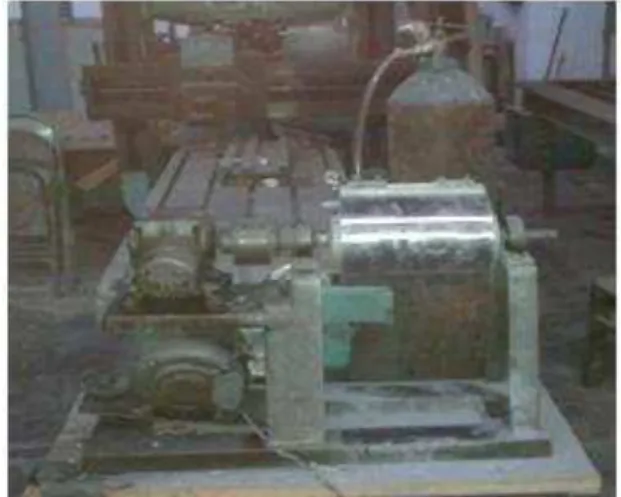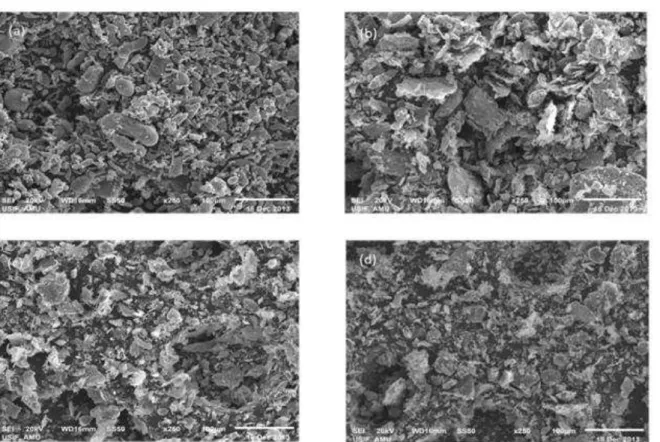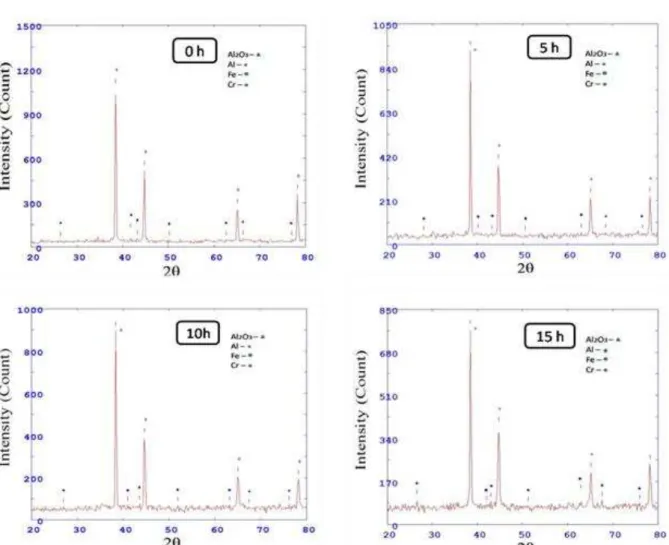Effect of Milling Time on Al-Fe-Cr-20 Wt. % Al
2O
3composite
Prepared Through Ball Milling
Hameedur Rehman Khan
1, M. Arif Siddiqui
21
(Mechanical Engineering department, Zakir Hussain college of Engineering and Technology (AMU), Aligarh- 202002, UP, India)
2
(Mechanical Engineering department, Zakir Hussain college of Engineering and Technology (AMU), Aligarh- 202002, UP, India)
ABSTRACT
One of the main challenges towards achieving a homogeneous distribution of the ceramic phase in the metal matrix composites is agglomeration of the reinforcement particles. Mechanical alloying is among the most important processing techniques used for manufacturing of metal matrix composites (MMCs).An attempt was made to synthesize Al-Fe-Cr-Al2O3composites synthesized through mechanical alloying. Al2O3 is used as
reinforcement. Ethanol (5 wt. %) has been used as a process control agent (PCA). Mechanical alloying is carried out in a conventional ball mill using stainless steel grinding media at 115 rpm in the argon environment for 5h, 10h and 15h. The ball to powder weight ratio was maintained at 20:1. The characterization of the ball milled powder was followed by scanning electron microscopy (SEM). Showed the formation of a homogeneous phase for all compositions after milling for 15 h. XRD patterns were recorded for the milled powders, and analyzed using Williamson–Hall method and Scherrer’s equation to determine the lattice strain and grain size.EDX is performed to check the contamination of composites during the mechanical alloying.XRD is used to study structural evolution of synthesized aluminium composite. Effect of milling time is investigated on synthesized Al-Fe-Cr-20 wt. % Al2O3 composites.
Keywords
: metal matrix composites, agglomeration, mechanical alloying, reinforcement, PCA.I.
INTRODUCTION
In the last three decades metal matrix composites (MMCs) have gained a considerable interest. As the addition of ceramic reinforcement (oxides, carbides, borides etc) in the metallic matrix can improve properties compared to conventional engineering materials [1, 2].The nature and distribution of reinforcement in the metal matrix highly affects the
properties of MMC’s [3]. Due to the light weight,
high specific strength, high thermal and electrical conductivity aluminum is the most used matrix for the metal matrix composites [4]. A good combination of ductility and high strength can be achieved with addition of Al2O3as reinforcements in aluminium
matrix [5]. AMCs are widely used in several industrial areas such as defense, automotive and aerospace [6]. Iron-aluminium-chromium alloys are used as structural materials and coatings for high-temperature applications [7]. Due to the formation of a dense, protective scale they exhibit excellent corrosion resistance. Alumina shows a low rate constant, even at elevated temperatures of above 1000 0C [8]. Particles reinforced metal matrix composites can be produced through several methods, which comprises stir casting, powder
Mechanical alloying (MA) has an advantage over other methods as it provides homogeneous distribution of the fine reinforcement particles within the matrix [10]. Ceramic reinforcement addition into a ductile matrix has a significant effect on the structural evolution during ball milling. Mechanical alloying is a complex process and optimization of a number of variables is required to achieve the desired phase or microstructure. These variables are type of mill, milling speed, milling time, BPR, milling atmosphere, PCA etc. Many researchers focused their researches to characterize and analyses the effect of different variables on the metal matrix composites prepared through mechanical alloying [11-16].
The purpose of the work is to investigate the effect of milling time on grain properties of Al-Fe-Cr-20 wt. %Al2O3 composites synthesized through
ball milling. The composites has been studied by taking samples at different milling times ( 0 h, 5 h, 10 h and 15h ).
II.
EXPERIMENTAL PROCEDURE
In the present study, Al (99.7%), Fe (99.5%), Cr (99.9%) and Al2O3 (99%) with average particle size of 48, 150, 100 and 100 µm respectively were used asFig. 1 Image of conventional ball mill
III.
RESULTS AND DISCUSSION
3.1 Morphological changesFig. 2 shows the SEM micrograph of composite powder at different stages of ball milling which occurred during the synthesis of the Al-Fe-Cr-20 wt. % Al2O3 composites powder. The sample with no
ball milling exhibits the elongated particles with broad variation in their size (Fig. 2a). As the ball milling starts an appreciable increase in particle size can be observed due to in initial stages of ball milling, the powder particles are soft and cold welding predominates. Due to deformation and cold welding the particles become somewhat irregular and flaky (Fig. 2b). With further increase in milling time the particles get work hardened and Ethanol (5 wt.
Philips Brooker D8 Advanced X-ray diffractometer. X-ray diffraction patterns were recorded from 20˚ to
80˚ with an accelerating voltage of 40 KV and current is maintained at 40mA. X ray diffraction (XRD) patterns of powders were taken in air atmosphere data were collected with a counting rate
of θ˚/min. Grain size and lattice strain during milling
stages are calculated by using Scherrer’s equation and Williamson-Hall method.EDX is performed to check the contamination of composites during the mechanical alloying
�= 0.9�
�cos (1)
�cos = 0.9 � � + 2 sin (2) Where B, , λ, D and are full width at half
maximum (FWHM), peak position, wave length, grain size and lattice strain, respectively.
Fig. 2 SEM images of Al-Fe-Cr-20 wt. % Al2O3 composite powder after (a) 0 h, (b) 5 h, (c) 10 h and (d) 15 h of ball milling.
3.2 EDX Analysis
EDX analysis of the Al-Fe-Cr-20 wt. % Al2O3 composite powders without ball milling and with 15 hours of ball milling shows that contamination is not found in the prepared composites due to low milling peed of 115 rpm and more importantly as the ball milling is performed in argon atmosphere. At low milling speed the temperature rise during ball milling is low and reduces the chance of any phase transformation during the process. When the ball milling is performed in inert atmosphere it eliminates
the chance of oxide and nitride formation during the synthesis of composites.
Moreover the grinding medium and vial is made up of same material (stainless steel). So it also eliminates the cross contamination of the prepared samples.
Fig. 3 shows the EDX spectra for the Al-Fe-Cr-20 wt. % Al2O3 composite powders without and with
Fig. 4 XRD patterns of Al-Fe-Cr-20 wt. % Al2O3 composite powder after (a) 0 h, (b) 5 h, (c) 10 h and (d) 15 h
of ball milling.
3.3 X-ray diffraction analysis
Fig. 4 shows the XRD patterns of the ball milled Al-Fe-Cr-20 wt. % Al2O3 composites powder at different milling times. Peaks corresponding to Al2O3 (hexagonal), Al (FCC), Fe (BCC) and Cr (BCC) are observed in all the diffraction patterns of the composite powder. The XRD pattern shows the peaks of Iron and chromium and alumina are clearly visible but having the low intensities due to their low percentages in the sample. By comparing the patterns of 0 hour and 5 hours it can be noticed the peak of 5 hours pattern is slightly narrow and intensity is comparable than 0 hour XRD pattern. It is due to the fact that in initial stages of ball milling, the powder particles are soft and cold welding predominates and an increase in particle size is observed after 5 hours of ball milling. The broadness of peak is increased in the 10 hours milled sample and intensity diminished. The broadness of peak shown by the patterns of 10 hours and 15 hours are quite similar in appearance as
the steady state has been achieved and no further significant grain refinement will occur with an increase in milling time.
3.4 Grain Size and Lattice Strain
Fig.5 Variation of grain size of Al-Fe-Cr-20 wt. % Al2O3 composites with different milling time.
Fig.6 Effect of milling time on lattice strain of Al-Fe-Cr-20 wt. % Al2O3 composites.
The lattice strain is increasing as the particle size decreases due to dislocation in lattice caused by distortion effect. As shown by Fig. 6 the lattice strain diminishes at the milling time of 5 hours due to the increase in grain size. Sample with 10 hours of milling shows drastic increase in lattice strain due to high reduction in grain size. By further increase in milling time, change in grain size is insignificant. So the increase in lattice strain is also negligible as the two has an inverse relationship between them.
IV.
Conclusions
In the present study, Al-Fe-Cr-20wt. % Al2O3
composites synthesized through ball milling. Characterization of the ball milled powders confirms a uniform distribution of the Al2O3 reinforcements in
the Al matrix was obtained after 15 hours of ball milling. By using Scherrer equation and Williamson- Hall method grain Size and lattice strain has been calculated. The grain size increases in initial stage of ball milling due to cold welding and then decrease with milling time as the fracturing dominates in final stages. The grain size of 23.07 nm was found after 15 hours of ball milling whereas the lattice strain increases to a value of 0.235 %. The EDX analysis confirms that no contamination takes place during the synthesis of sample through ball milling.
References
[1] S. C. Tjong, Z. Y. Ma, and Y. L. Li, The
performance of aluminium-matrix
composites with nanometric particulate Si– N–C reinforcement, Composites Science and Technology, 59, 1999, 263–270.
[2] A. Rabiei, L. Vendra, and T. Kishi, Fracture behavior of particle reinforced metal matrix composites, Applied Science and Manufacturing, 39, 2008, 294-300.
[3] M. Rahimian, N. Ehsani, N. Parvin, and H.
the properties of Al-Al2O3 composites,
Journal of material Processing Technology, 209, 2009, 5387-5393.
[4] G. B. V. Kumar, C. S. P. Rao, N. Selvaraj, and M. S. Bhagyashekar, Studies on Al6061-SiC and Al7075-Al2O3 Metal Matrix Composites, Journal of Minerals and Materials Characterization & Engineering, 9, 2010, 43-55.
[5] L. A. Dobrzaski, M. Kremzer, and M. Drak, Modern composite materials manufactured by pressure infiltration method, Journal of
Achievements in Materials and
Manufacturing Engineering, 30, 2008, 121-128.
[6] S. Shamsuddin, S. B. Jamaludin, Z. Hussain, and Z. A. Ahmad, Characterization of Fe-Cr-Al
2O3 composites fabricated by powder metallurgy method with Varying Weight Percentage of Alumina, Journal of Physical Science, 19, 2008, 89–95.
[7] J. Klower, High temperature corrosion behavior of iron aluminides and iron– aluminium–chromium alloys, Materials and Corrosion, 47, 1996, 685–694.
[8] P. Kofstad, Fundamental aspects of corrosion by hot gases, Materials Science and Engineering, 120–121, 1989, 25-29. [9] S. Paris, E. Gaffet, F. Bernard, and Z. A.
Munir, Spark plasma synthesis from mechanically activated powders: a versatile route for producing dense nanostructured iron aluminides, Scripta Materialia, 50, 2004, 691–696.
[14] C. L. Chen, and Y. M. Dong, Effect of mechanical alloying and consolidation process on microstructure and hardness of nanostructured Fe-Cr-Al ODS alloys, Material Science and Engineering: A, 528, 2011, 8374-8380.
[15] J. Xing, Y. Bai, H. Wu, Z. Liu, Y. Gao, and S. Ma, Study on preparation and mechanical properties of Fe3Al- 20 wt.%Al2O3 composites, Materials & Design, 39, 2012, 211-219.
[16] R. Sachan, and J. W. Park, Formation of nanodispersoids in Fe–Cr–Al/30%TiB2 composite system during mechanical alloying, Journal of Alloys and Compounds, 485, 2009, 724-729.
[17] A. Mazahery, H. Abdizadeh, and H. R. Baharvandi, Development of high performance Al356/nano- Al2O3 composites, Materials Science and Engineering :A, 518, 2009, 61–64.
[18] C. Suryanarayana, Mechanical alloying and milling (New York, Marcel Dekker, 2004). [19] H. Mahboob, S. A. Sajjadi, and S. M.
Zebarjad, Synthesis of Al-Al2O3 nano-composite by mechanical alloying and evaluation of the effect of ball milling time on the microstructure and mechanical properties,The International Conference on MEMS and Nanotechnology, Kuala Lumpur, Malaysia, 2008, 240-245.


